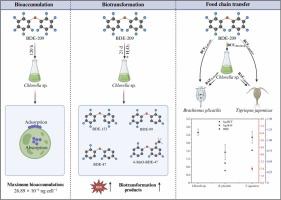A toxicokinetic study of decabromodiphenyl ether (BDE-209) in marine planktonic food web-adsorption/absorption kinetics, biotransformation, transfer patterns along the food chain
IF 11.3
1区 环境科学与生态学
Q1 ENGINEERING, ENVIRONMENTAL
引用次数: 0
Abstract
Concerns about the residual decabromodiphenyl ether (BDE-209) in marine environments are still existing as its ban of commercial use. Systematically toxicokinetic analysis of BDE-209 in planktonic food chains was conducted in this study, including the bioaccumulation, biotransformation, and transfer patterns of BDE-209 in the Chlorella sp.-Brachionus plicatilis/Tigriopus japonicus food chains. Based on the regression of pseudo-first-order (PFO), pseudo-second-order (PSO), and intraparticle diffusion model, the bioaccumulation of Chlorella sp. for BDE-209 could be concluded as the fast adsorption (12.83 × 10−4 ng h−1 cell−1) process followed by the fast absorption (10.04 × 10−4 ng h−1 cell−1) process, both of which were rate-limiting steps (kdiff,1 = 11.04 × 10−4 ng h−0.5 cell−1; kdiff,2 = −3.13 × 10−4 ng h−0.5 cell−1). Debromination of BDE-209 happened before oxidation in Chlorella sp. cells, and hydrogen peroxide (H2O2) stress accelerated the two processes, especially the debromination. Chlorella sp. showed a higher log BCF value (2.53 L kg−1) than B. plicatilis (1.54 L kg−1) and T. japonicus (2.29 L kg−1), and the main way for zooplankton BDE-209 uptake was feeding on contaminated Chlorella sp. The BMF values of BDE-209 along the two food chains were both < 1, showing the biodilution effect. This is the first toxicokinetic study of BDE-209 for marine plankton in lab, provided solid data basis for evaluating the ecological risks of BDE-209 in marine environments, with great ecological significance.

十溴联苯醚(BDE-209)在海洋浮游食物网中的毒性动力学研究——吸附/吸收动力学、生物转化、沿食物链转移模式
对海洋环境中残留的十溴联苯醚(BDE-209)的担忧在禁止其商业使用的情况下仍然存在。本研究对BDE-209在浮游生物食物链中的毒动力学进行了系统分析,包括BDE-209在小球藻-柔弯尾轮虫/日本虎藻食物链中的生物积累、生物转化和转移模式。基于伪一阶(PFO)、伪二阶(PSO)和颗粒内扩散模型的回归分析,小球藻对BDE-209的生物富集过程为快速吸附(12.83 × 10−4 ng h−1细胞−1)和快速吸收(10.04 × 10−4 ng h−1细胞−1),两者均为限速步骤(kdiff,1 = 11.04 × 10−4 ng h−0.5细胞−1);Kdiff,2 =−3.13 × 10−4 ng h−0.5 cell−1)。在小球藻细胞中,BDE-209的脱溴发生在氧化之前,过氧化氢(H2O2)胁迫加速了这两个过程,尤其是脱溴。小球藻的对数BCF值(2.53 L kg−1)高于被污染的小球藻(1.54 L kg−1)和日本刺参(2.29 L kg−1),浮游动物对BDE-209的主要吸收途径是取食被污染的小球藻。1、表现出生物稀释效果。本研究首次在实验室进行了BDE-209对海洋浮游生物的毒动力学研究,为评价BDE-209在海洋环境中的生态风险提供了坚实的数据基础,具有重要的生态学意义。
本文章由计算机程序翻译,如有差异,请以英文原文为准。
求助全文
约1分钟内获得全文
求助全文
来源期刊

Journal of Hazardous Materials
工程技术-工程:环境
CiteScore
25.40
自引率
5.90%
发文量
3059
审稿时长
58 days
期刊介绍:
The Journal of Hazardous Materials serves as a global platform for promoting cutting-edge research in the field of Environmental Science and Engineering. Our publication features a wide range of articles, including full-length research papers, review articles, and perspectives, with the aim of enhancing our understanding of the dangers and risks associated with various materials concerning public health and the environment. It is important to note that the term "environmental contaminants" refers specifically to substances that pose hazardous effects through contamination, while excluding those that do not have such impacts on the environment or human health. Moreover, we emphasize the distinction between wastes and hazardous materials in order to provide further clarity on the scope of the journal. We have a keen interest in exploring specific compounds and microbial agents that have adverse effects on the environment.
 求助内容:
求助内容: 应助结果提醒方式:
应助结果提醒方式:


